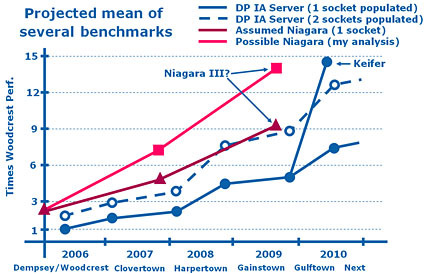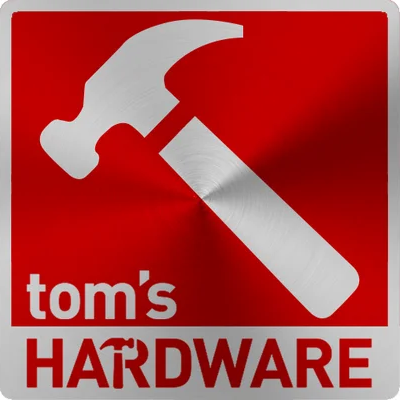Intel aims for 32 cores by 2010
Chicago (IL) and Westlake Village (CA) - Five years ago, Intel envisioned processors running at 20 GHz by the end of this decade. Today we know that the future will look different. CPUs will sacrifice clock speed over core count: Intel's first "many core" CPU, will run at only two thirds of the clock speed of today's fastest Xeon CPU - but achieve 15x the performance, thanks to 32 cores.
"Dual-core" is a term Intel never really warmed up to. In fact, two cores per processor is just the first step on a ladder of increasing core counts that, as we believe today, will lead the microprocessor industry into another period of growth. Instead of promoting "dual-core", Intel typically talks about "multi-core" - a term the company internally refers to as project "Kevet" - and explains the press and analysts that "many-cores" - processors that potentially could hold "dozens of cores" - will be available sometime in the future.
So far, it has been unclear when those "many-cores" will actually be available. Documents provided by an industry source and seen by TG Daily, however, indicate that at least "dozens of cores" may be still some time away. The first processor of "Keifer" - Intel's project name for many-core processors - will be surfacing in the 2009/2010 time frame and integrate 32 cores (128 threads total): The first Keifer chip will be manufactured in 32 nm and use eight processing nodes with four cores each. Every node will have direct access to one 3 MB on-die last level cache (LLC) and 512 kB L2 cache. There will be a total of 8 x 3 MB LLC slices that are connected by a ring architecture and represent a total 24 MB of cache. (More details about Intel's roadmap to Keifer are available in Tom's Hardware's article 32-core processors: Intel reaches for (the) Sun)
Intel's road to 32 cores
While it is worth noting that Intel expects Keifer to result in a 15x performance jump over today's Xeon 5100 processors at just 2 GHz clock speed, it is especially interesting that Intel has begun investigating competitive products to estimate the performance requirements of its products in the 2010 time frame. And surprisingly, Intel does not consider AMD's Opteron and successors as Kevet's and Keifer's benchmark. The documents seen by TG Daily aim Keifer at Sun's "Niagara" architecture, which is currently available in the "Ultra Sparc T1" processor. The T1 was launched last year with great fanfare as 1.2 GHz 8-core processor with 3 MB L2 cache and capable of handling a total 32 threads at a peak power of just 72 watts. Sun currently offers the T1 in the T1000 and T2000 server series - rack-mounted 1U and 2U servers with prices ranging from about $3500 to just under $30,000.
Intel can't touch the performance of the T1 in its home turf at this time and the specifications of Niagara's successors are widely based on speculations. However, Intel apparently assumes that Sun will be careful in increasing core count over time as more threading capability, more cache and a floating point unit are likely to yield more performance for the architecture. Niagara II, due as a 65 nm processor in 2007, may debut as an 8-core, 1.4 GHz chip that is able to run 64 threads and offer 2x - 3x the performance over today's T1 chip, Intel's believes. The company estimates that the 45 nm Niagara III, due in 2009, will double its cores to 16, run with clock speeds between 1.4 and 2.0 GHz and process 128 threads to achieve 4x - 6x the performance of today's T1 processor.
The detail of Intel's Niagara analysis suggests that the company has put substantial effort into "investigating" the potential of the Niagara architecture. The obvious result of this analysis is that Intel takes Niagara serious enough to align its x86 processor performance with the evolution of Sun's T1. Intel knows that a simple increase of threads combined with "multi-core" processors won't allow the company to keep Sun's pace. Engineers at the firm believe that a new architecture - which is rumored to be launched in 2008 - and 32 cores are necessary to catch up and ultimately trump Sun in the 2009/2010 time frame: Key to Intel's advantage may be clock speed, once again: The company estimates that Niagara III won't be able to run faster than 2.0 GHz - while Keifer will run at least at 2.0 GHz.
Get Tom's Hardware's best news and in-depth reviews, straight to your inbox.
Related articles:
Intel quad-core processors may see spike in power - sources
Intel preps quad-core mobile chip, new CPU architecture for 2008 - analyst
IDF keynotes: Welcome to 'Intel 3.0,' with first look at quad-core CPUs
Intel shows off first x86 quad-core processor
Intel roadmap update - prototypes of first quad-core desktop processor built
Tom's Hardware is the leading destination for hardcore computer enthusiasts. We cover everything from processors to 3D printers, single-board computers, SSDs and high-end gaming rigs, empowering readers to make the most of the tech they love, keep up on the latest developments and buy the right gear. Our staff has more than 100 years of combined experience covering news, solving tech problems and reviewing components and systems.

